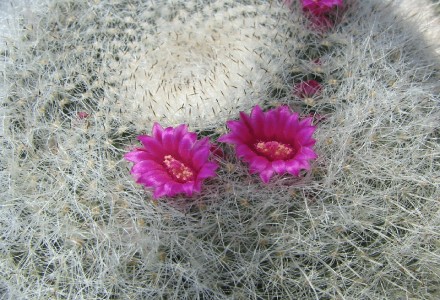
Old Woman Cactus Facts
- First of all, the somewhat distinctive term Old Woman Cactus forms the common name for a very surprising species of succulent. The plant also bears the equally distinctive scientific name of the Mammillaria hahniana. But, by either name it remains a highly interesting species.
- People commonly refer to the remarkable plant due to a characteristic of its physical appearance. Thus, it receives its most used common name due to the presence of the grayish hairs that cover it. These serve to protect it from the harsh sun common to its native habitat.
- Furthermore, the remarkable species evolved in a region filled with vast numbers of other succulents. In point of fact, this particular species represents only one of the more than 500 found in the region. Quite sadly, naturally occurring populations of this cactus are rapidly disappearing.
- Propagation of this species by commercial nurseries has greatly reduced the demand for plants illegally collected from naturally occurring populations, however. Nevertheless, the IUCN presently lists the Old Woman Cactus as Near Threatened on its Red List of Threatened Species.
Related Articles
Living Stones Christmas Cactus Kalanchoe
Old Woman Cactus Physical Description
One of the most remarkable things about the remarkable Old Woman Cactus is its adaptability. That’s because the plant represents a succulent that grows well in either direct sun or partial shade. In either setting, in addition to the white hairs from which its name derives, the plant also produces small flowers.
These beautiful blooms typically display a dark pink color, creating a striking contrast to the rest of the plant. Additionally, the visibly stunning funnel-shaped blooms usually grow in a fascinating circular pattern. This surprising cactus most commonly blooms in the late Spring and early Summer.
But the species known as the Old Woman Cactus does not stop there with the wonders. That’s because its lovely flowers serve as precursors to the production of small red berries. The globe-shaped berry attains an average diameter of about 8 in (20 cm). It also most commonly develops in groups or clusters.
- Kingdom: Plantae
- Phylum: Angiosperms
- Class: Eudicots
- Order: Caryophyllales
- Family: Cactaceae
- Genus: Mammillaria
- Species: M. hahniana
Photographer: Dr. Nasser Halaweh
CC License: https://bit.ly/1eBd9Ks
Old Woman Cactus Distribution, Habitat, and Ecology
The visually distinctive Old Woman Cactus evolved as endemic to a severly limited habitat range. In fact, that region of habitation consists only of the Mexican state of Guanajuato. That comes as no surprise, however, since the country of Mexico, in North America, remains an important center of diversity for the Cactaceae family.
In addition, given the region of the world in which it evolved, it prefers the same type of environment as most related species. As a result, its natural habitat consists primarily of very dry and arid regions. Furthermore, though, it also requires regions with relatively poor soil and generally high heat conditions.
It’s quite well adapted for the climate, however. The raised tubercules of the Old Woman Cactus store comparatively vast quantities of water from the sporadic rainfall in its native habitat. It also does not long survive under wet conditions. Therefore, though it has become popular in cultivation, care must be taken
Species Sharing Its Range
Tiger Rattlesnake Turbinicarpus alonsoi Giant Mesquite Bug
Check out our other articles on Magnificent Mammals of Australia, White Spotted Puffer, Jeita Grotto, Korean Fir, Geoffroy’s Cat, Lord Howe Island Stick Insect, Purple Frog

